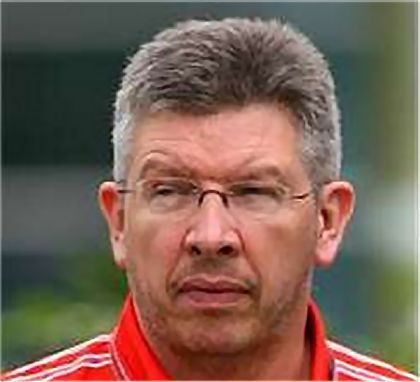- 12 Dec 10, 21:21#230345
Tom Walkinshaw
December 12, 2010 by joesaward
It is with great regret that we must record the passing of Tom Walkinshaw at the age of 63. Tom had been battling cancer for some years.
Walkinshaw was a great achiever and a tough businessman. He was forever pushing the limits in all walks of his life and this resulted in controversy, but also in much success, notably with the Jaguar sports cars of the late 1980s and early 1990s. He masterminded the success of the Benetton F1 team in 1994 but when it came to running his own team, he never enjoyed the success he so desired. His Arrows team eventually closed down and Tom returned to touring cars, where he had enjoyed much success. On a personal note, I fought many battles in my career with Walkinshaw, but one could not help but like him. He was very kind to me in the early days of my career, helping me to survive the difficult early years as a freelance and I will always be grateful for that. The other thing one could never fault was his passion, not just for motorsport, but also for life. He lived his life to the full – and that is the best epitaph a man can have.
He grew up in his native Scotland and came to racing thanks to the exploits of a local garage owner, who raced Minis. Tom found the money to buy a Formula Ford car and in 1968 began racing in local events. The following year he was the Scottish Formula Ford 1600 champion and headed south to England to race in Formula 3 in 1970. After an abortive start with a Lotus he joined the March works team, although that relationship ended in disarray after his sponsorship did not materialise. Things were not helped when Walkinshaw broke both his legs in a big accident. Although he failed to establish himself in single-seater racing Tom was picked up by Ford and hired to develop cars and to race touring cars in 1974 and he quickly won his class in the British Touring Car Championship. After his Ford contract ended he established Tom Walkinshaw Racing and in 1976 scored his first major victory sharing a BMW CSL with John Fitzpatrick at Silverstone. TWR began by preparing BMWs and this culminated the BMW County Challenge in 1979 and 1980 while Tom continued to race a variety of different machinery. His Mazda RX7s won the British Touring Car Championship in 1980 and 1981 with Win Percy driving, while in the latter year Walkinshaw shared victory in the Spa 24 Hours with Pierre Dieudonné. TWR grew fast and bought a string of garages across the UK. The team also began to develop touring cars for both Rover and Jaguar. The company also prepared the Paris-Dakar winning Range Rover for Rene Metge and Bernard Giroux. In 1982 TWR began to race Jaguars in the European Touring Car Championship and Rovers in the British series. There was much success but also controversy with the team being stripped of its British title in 1983 when the Shawcross Tribunal of Enquiry ruled that the TWR Rovers were running illegal rockers and bodywork. This resulted in Rover switching to the European Touring Car series where the team competed against TWR Jaguars. That year Walkinshaw won the European title in a Jaguar XJS, including victory in the Spa 24 Hours. This led to Jaguar commissioning TWR to build a sportscar for the Le Mans 24 Hours.
While Rover continued to win in touring cars, Jaguar became successful in sportscars while TWR also began building cars for the IMSA series in the United States and for Holden in Australia. In 1987 and 1988 Jaguar won the World Sportscar title and won the classic 24 hour races at Le Mans and Daytona. In 1991 Jaguar won a third World Sportscar title.
Walkinshaw was elected chairman of the British Racing Drivers Club in this era and had big plans for the club, many of which were later adopted by those who followed, but his ambitions for the club were too radical and he was ousted from the role after a plan was announced to establish a Silverstone Motor Group.
While all this was taking place Walkinshaw had been appointed the Engineering Director of the Benetton F1 team and TWR had begun producing roadgoing Jaguar XJ220s for sale to the public. There was a further deal with Aston Martin. In touring car racing Walkinshaw began a new cooperation with Volvo.
In 1994 Benetton won the Formula 1 World Championship despite much controversy and at the end of the year Benetton boss Flavio Briatore was pressured to move Walkinshaw out of the team to Ligier, which the Italian had acquired. Walkinshaw intended to buy the French team but Briatore left him hanging and they fell out early in 1996. Walkinshaw bought the Arrows team instead. That same year a TWR-designed Porsche sportscar won the Le Mans 24 Hours while the company also went into business to manufacture road cars with Volvo. In 1997 Walkinshaw put together a strong package for Arrows including Yamaha engines, Bridgestone tyres and World Champion Damon Hill as a driver and the team came close to winning in Hungary but at the end of the year Hill moved on and the team ran into financial trouble and struggled until a major new sponsorship deal was done with Orange at the start of the 2000 season. In Australia he built up a hugely successful business racing and building Holden road cars. The F1 team continued until 2002 and attempts to revive it with a conortium led by his friend Charles Nickerson, who had raced as “Chuck Nicholson” – also failed and Walkinshaw faded from the F1 scene. He tried hard to negotiate a Grand Prix in Russia but when that project failed, Walkinshaw concentrated his efforts on his Holden Racing Team, which was established back in 1990 and has since won the Australian V8 Supercar Series six times, and has won no fewer than six victories at the Bathurst 1000 six times.
December 12, 2010 by joesaward
It is with great regret that we must record the passing of Tom Walkinshaw at the age of 63. Tom had been battling cancer for some years.
Walkinshaw was a great achiever and a tough businessman. He was forever pushing the limits in all walks of his life and this resulted in controversy, but also in much success, notably with the Jaguar sports cars of the late 1980s and early 1990s. He masterminded the success of the Benetton F1 team in 1994 but when it came to running his own team, he never enjoyed the success he so desired. His Arrows team eventually closed down and Tom returned to touring cars, where he had enjoyed much success. On a personal note, I fought many battles in my career with Walkinshaw, but one could not help but like him. He was very kind to me in the early days of my career, helping me to survive the difficult early years as a freelance and I will always be grateful for that. The other thing one could never fault was his passion, not just for motorsport, but also for life. He lived his life to the full – and that is the best epitaph a man can have.
He grew up in his native Scotland and came to racing thanks to the exploits of a local garage owner, who raced Minis. Tom found the money to buy a Formula Ford car and in 1968 began racing in local events. The following year he was the Scottish Formula Ford 1600 champion and headed south to England to race in Formula 3 in 1970. After an abortive start with a Lotus he joined the March works team, although that relationship ended in disarray after his sponsorship did not materialise. Things were not helped when Walkinshaw broke both his legs in a big accident. Although he failed to establish himself in single-seater racing Tom was picked up by Ford and hired to develop cars and to race touring cars in 1974 and he quickly won his class in the British Touring Car Championship. After his Ford contract ended he established Tom Walkinshaw Racing and in 1976 scored his first major victory sharing a BMW CSL with John Fitzpatrick at Silverstone. TWR began by preparing BMWs and this culminated the BMW County Challenge in 1979 and 1980 while Tom continued to race a variety of different machinery. His Mazda RX7s won the British Touring Car Championship in 1980 and 1981 with Win Percy driving, while in the latter year Walkinshaw shared victory in the Spa 24 Hours with Pierre Dieudonné. TWR grew fast and bought a string of garages across the UK. The team also began to develop touring cars for both Rover and Jaguar. The company also prepared the Paris-Dakar winning Range Rover for Rene Metge and Bernard Giroux. In 1982 TWR began to race Jaguars in the European Touring Car Championship and Rovers in the British series. There was much success but also controversy with the team being stripped of its British title in 1983 when the Shawcross Tribunal of Enquiry ruled that the TWR Rovers were running illegal rockers and bodywork. This resulted in Rover switching to the European Touring Car series where the team competed against TWR Jaguars. That year Walkinshaw won the European title in a Jaguar XJS, including victory in the Spa 24 Hours. This led to Jaguar commissioning TWR to build a sportscar for the Le Mans 24 Hours.
While Rover continued to win in touring cars, Jaguar became successful in sportscars while TWR also began building cars for the IMSA series in the United States and for Holden in Australia. In 1987 and 1988 Jaguar won the World Sportscar title and won the classic 24 hour races at Le Mans and Daytona. In 1991 Jaguar won a third World Sportscar title.
Walkinshaw was elected chairman of the British Racing Drivers Club in this era and had big plans for the club, many of which were later adopted by those who followed, but his ambitions for the club were too radical and he was ousted from the role after a plan was announced to establish a Silverstone Motor Group.
While all this was taking place Walkinshaw had been appointed the Engineering Director of the Benetton F1 team and TWR had begun producing roadgoing Jaguar XJ220s for sale to the public. There was a further deal with Aston Martin. In touring car racing Walkinshaw began a new cooperation with Volvo.
In 1994 Benetton won the Formula 1 World Championship despite much controversy and at the end of the year Benetton boss Flavio Briatore was pressured to move Walkinshaw out of the team to Ligier, which the Italian had acquired. Walkinshaw intended to buy the French team but Briatore left him hanging and they fell out early in 1996. Walkinshaw bought the Arrows team instead. That same year a TWR-designed Porsche sportscar won the Le Mans 24 Hours while the company also went into business to manufacture road cars with Volvo. In 1997 Walkinshaw put together a strong package for Arrows including Yamaha engines, Bridgestone tyres and World Champion Damon Hill as a driver and the team came close to winning in Hungary but at the end of the year Hill moved on and the team ran into financial trouble and struggled until a major new sponsorship deal was done with Orange at the start of the 2000 season. In Australia he built up a hugely successful business racing and building Holden road cars. The F1 team continued until 2002 and attempts to revive it with a conortium led by his friend Charles Nickerson, who had raced as “Chuck Nicholson” – also failed and Walkinshaw faded from the F1 scene. He tried hard to negotiate a Grand Prix in Russia but when that project failed, Walkinshaw concentrated his efforts on his Holden Racing Team, which was established back in 1990 and has since won the Australian V8 Supercar Series six times, and has won no fewer than six victories at the Bathurst 1000 six times.
Last edited by texasmr2 on 12 Dec 10, 21:27, edited 1 time in total.
"Sanity and happiness are an impossible combination".
Mark Twain
Mark Twain






